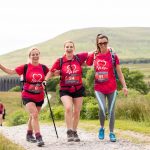Elderly people should learn to shimmy like Strictly’s Bruce Forsyth or Len Goodman to stave off heart disease.
A study found those who took up Latin dancing, such as the cha cha cha or salsa, for four months walked faster and improved their physical fitness – factors that are known to boost cardiovascular health.
Those who took part in the twice weekly sessions finished a 400 metre walk in just under 392 seconds, compared with almost 430 seconds beforehand. And leisure time exercise rose from 650 to almost 818 minutes a week.
Meanwhile, participants assigned to health education classes instead had much smaller improvements, completing the walk in about 409 seconds compared with their earlier 419, and their physical activity just increased from 522 to 628 minutes.
The findings presented at the American Heart Association’s Epidemiology/Lifestyle 2016 Scientific Sessions in Phoenix could help inspire all adults to get a minimum recommended 150 minutes of moderate physical activity or at least 75 minutes of vigorous physical activity each week.
Regular physical activity has been shown to reduce the risk of heart disease, stroke, type 2 diabetes and complications associated with advancing age as well as improve balance, mobility and reduce stress.
In the study 54 Spanish-speaking 65 year olds most of whom were unfit Mexican women were randomly sent either to the dance or health education program. They completed questionnaires about their leisure time physical activity and the walk test at the start and end.
The dance program is called BAILAMOS©, a culturally-tailored, community-based lifestyle intervention developed at the University of Illinois at Chicago and included four different styles — merengue, bachata, cha cha cha and salsa — led by an instructor, with more complex choreography as the program progressed.
Increasing physical activity is one of the key 2020 Impact Goals of the American Heart Association.
Priscilla Vasquez, of the University of Illinois, said scaling up such a culturally-attuned, and what appears to be a fun intervention could have significant public health effects.
She said: “There are many barriers older Latino adults face, and they are busy with caregiving and other responsibilities, so often physical activity takes a back seat and many times the opportunities are unavailable.
“This program engaged them on many levels, physically, culturally and emotionally. Anecdotally, I have heard participants say attending dance class is their stress relief.
“They also interact with others and build community. This impacts their physical as well as emotional health and wellbeing.”
Dancing could have wider health implications, too.
Ms Vasquez, a doctoral student, said her researchers are interested in testing whether BAILAMOS© can help older Latinos already experiencing mild cognitive impairment.
She added: “We are interested in using magnetic resonance imaging to see if dancing positively affects their brains.”
Earlier this week it was reported people over the age of 40 who take part in dancing almost halve their risk of dying from cardiovascular disease.
In the first study of its kind Australian researchers analysed more than 48,000 people in Great Britain for a decade to find out how exercise affected their health.
They said people who danced had a 46% lower risk of cardiovascular death over a decade, compared to those who rarely or never danced.
By Mark Waghorn





